The stupid Haynes manual didn’t show an exploded view of the TX10 nor did it tell how to disassemble it. I checked the web, but no one seemed to be familiar with my particular problem.
In desperation, I resorted to exploratory surgery. I removed the case, cleaned it the best I could and cracked her open. What I found was an “overgrown timing belt” that was so badly worn that it was climbing teeth and clunking back down only to climb teeth again and so on, causing the terrible noise that I was hearing.
Armed with this knowledge and a new-found sense of purpose, I reassembled the case and reinstalled it so that I could still get back and forth to work while I gathered the parts. That alone was an ordeal; I needed the chain, new seals, speedometer drive and driven gears and a new speedo cable. All had to be special ordered.
Here are the parts.

They set me back over $450! The chain alone was about $300. I might not have needed the speedometer parts if the previous mechanic hadn’t put the drive gear in backwards. That wrecked both gears. I don’t know what caused the cable to break. Age, I guess.
The new chain was so stiff that I could form it into any shape that I wanted.
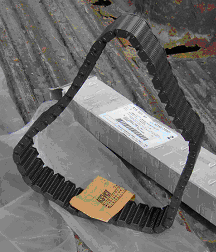
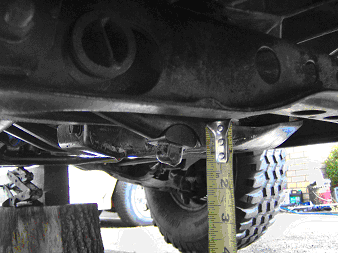
I started by blocking up the front end with my trusty portable stump. Measure the distance from the cross member to the torsion bar cams so you can set them back how they were when you reassemble them.
I had to dig through my box of busted wrenches to find this candidate. It was a broken 9/16 with a good box end. 9/16” is close enough to 14mm, so I took the torch to it and pretzeled the thing into what you see here.
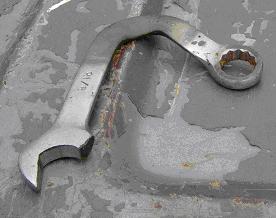
“Why?” you ask? This was my solution to that one S.O.B. bolt head that holds the left torsion bar to the driver side lower arm. I’m referring to the uppermost bolt that you can’t hold from turning because the axle is in the way. Thing of beauty, eh?
Remove the T-bars and cross member as a unit. Remove both drive shafts. Remove the dirt scoop from the bottom of the T-case. (Some refer to it as a guard.) Detach the vent tube from the top of the case. Disconnect the speedometer cable and hang it out of the way. With a 10mm socket, remove the speedo cable drive. Remove the drain plug and let it drain awhile. The chain holds a lot of oil between its plates and the oil does not run off of it very quickly.
I decided to leave the case in the truck because my good jack quit on me and without it, I have no safe way of handling something this heavy. If you decide to remove the case for this operation you will have to drain the transmission as well. You better have a big drain pan for that. You will also have to remove the shift lever from the side and unplug the switch wires. Unbolt the case and remove it.
Back out all of the case bolts shown in the next picture with a 12mm socket and a 6” extension. An air ratchet is ideal here. I left the bolts in the case so I wouldn’t get them mixed up, but I have to admit that it was tricky rotating the cover down while keeping the bolts from falling out. (I did it, though. J) There are two places where you can pry the case apart. Take your time and work it evenly. The goal here is to work the case off of two ball bearings that are lightly pressed into the outer case. Be gentle as it starts to come free because there are plastic oil troughs that could be damaged fairly easily.
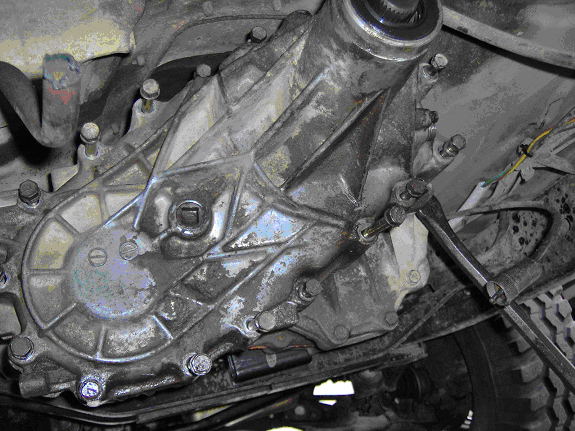
Here is what I saw once the cover was off. The chain was so slack that it was starting to drag against the case. Now you can understand why it was jumping over the teeth!
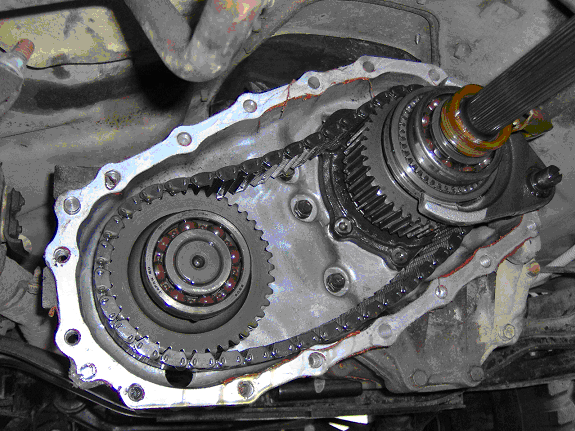
Remove the bolts from the cover and lay them out in order so they don’t get mixed up. It would probably be a good idea to stab them into a piece of cardboard like you would do with head bolts on an engine to keep them organized.
Clean the cover, especially the vent. Pry out the old rear seal and install a new one.
Shift it into 4L to keep everything form turning. Use an impact wrench to remove the front output flange nut. Pull the flange off the shaft.
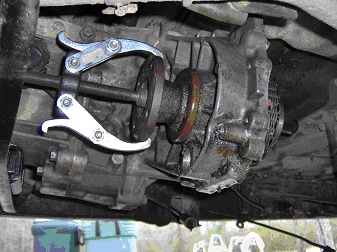
To remove the plastic speedo drive gear, use a tiny flat screwdriver to catch one end of the internal snap ring and work it out. Slide the gear off slowly because there is a small chrome ball that keys the gear in place. There is nothing to hold it once the gear is slid off, so be ready to catch it.

Remove the external snap ring and washer that retain the bearing. I had to wedge screwdrivers between the bearing and the gear face to get the bearing off. It took a good bit of patience and hammering to wedge it off. It would have been nice to have a puller long enough to do the job.

With the bearing removed, I had to get the shift fork off. Remove the snap ring that holds the fork on. If you are lucky, the whole mess will slide off the shaft as an assembly. I was not that fortunate. I had to get medieval on it. I used a puller on the fork to hold pressure while I beat on the end of the shaft with one of those big orange dead-blow hammers like they use in the NASCAR pits. Each time it moved a little, I put more pressure on the puller. You want to be careful here or you could potentially bend the fork. That would be undesirable.

I also used a pry bar between the backside of the gear and the steel flange bolted to the case.
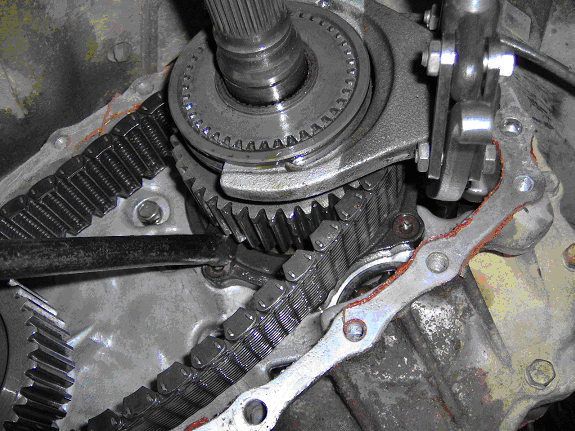
Don’t get in a hurry as things start to slide because there are needle bearings that want to fall out all over the place. There are also little key-like thingies between the gears that can fall out if you don’t move all of the parts as an assembly. The goal here is to back out the upper gear assembly just enough to pull the lower shaft out.
Here you can see one of the doohickies inside the gear assembly that key it together. All of this stuff has to be kept in alignment later when it goes back together, so get familiar with how it goes together.
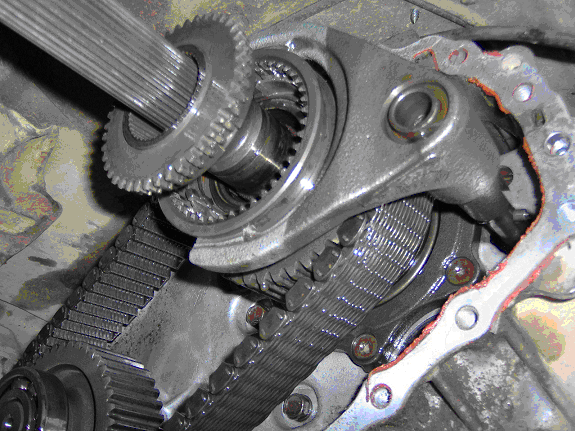
Look behind this cluster of parts for the needle bearings that I spoke of. Make sure they stay inside the gear, or the rollers will fall out.

Use the NASCAR hammer to knock the lower shaft free. Ease it out and let it hang.
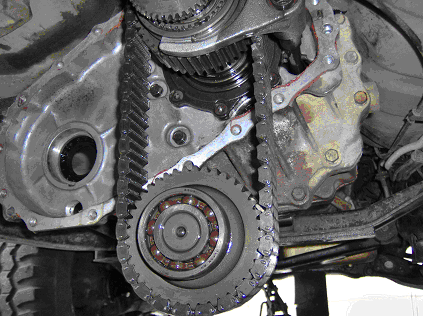
Work the upper assembly back carefully until the fork can be removed. With the fork out of the way, you can slide the assembly off of the shaft and take it to the bench.
Here is a blurry shot of the needle bearings. If any of the rollers fall out, slide the carrier out of the bore just enough to reinsert it from the outside of the bearing cage.
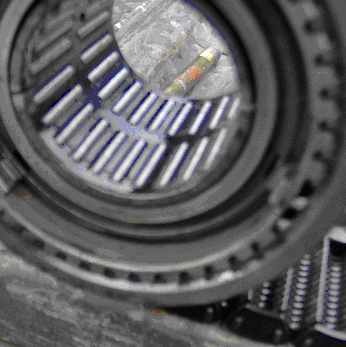
With the assembly on the bench, set the new chain next to the old chain that still has the gears in it. Make sure that the chain is facing the correct direction. I don’t know if it matters or not, but one edge of the chain has spring loaded plates. The spring loaded side was facing rearward on mine, so I made sure that I put the new one the same way.
Transfer the gear assemblies to the new chain. Work the chain around the gears to get the tightest fit that you can. This will help when you go to put the case back together. Trust me on this.
Take the time now to knock out the old front output shaft seal. I went ahead and put my new one in, but later realized that it would have been safer to wait until the shaft was back in place.
Reinstall the whole mess on the upper shaft. Bring the fork back into position as you slide the assembly onto the upper shaft. Once the fork is started on, get the lower shaft started in. BE PATIENT HERE! Work it all together very carefully. I had a lot of trouble coaxing the needle bearings back onto the shaft. Rotating the assemblies a bit at a time helped, but it was still tricky. If you had trouble getting the gears off of the splines as I did, you will most likely have to tap them back on with a plastic hammer. Go a little at a time, being sure to line up all of the doohickies as you go. Use the NASCAR hammer to drive the lower shaft’s front bearing into its bore in the case. The goal here is not to ruin anything.
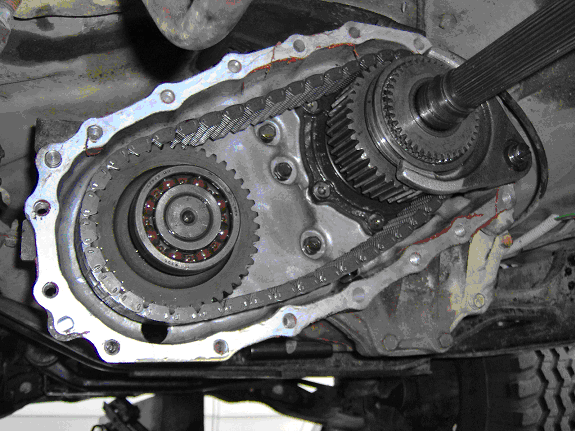
If all of the gears are all the way in, reinstall the bearing, washer and snap ring. Reinstall the snap ring on the shift fork shaft. Install the speedometer gear along with its little ball and internal snap ring. The deeply recessed side of the gear goes toward the (metal) gears. If you get it on backwards, it will be loose and floppy on the shaft.
I tried several ways to reinstall the plastic oil trough parts and came up with this as being the best method: Install the long piece in the front case and the tube-shaped part on the bearing as shown. Engage the end of the long piece with the two little tabs on the tubular part. As you can see, I broke the corner off of my trough, but it still works.
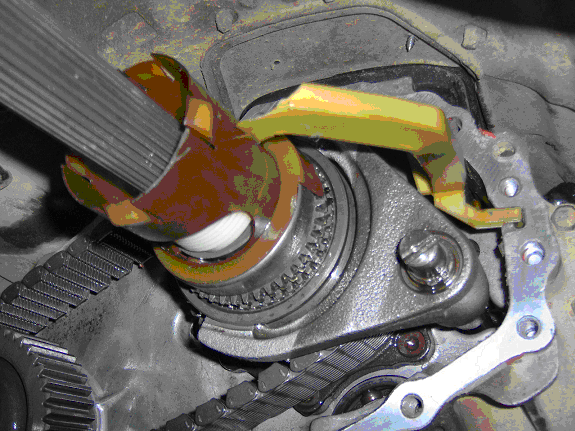
With all of the parts installed, spread the ends of the shafts as far apart as your strength allows. The new chain is tight and it pulls the shaft ends toward each other just enough to make it difficult to get the cover started over the bearings.
Apply a small continuous bead of (aluminum-safe) sealant to either case flange and carefully start the cover over the plastic parts. Work the case onto the bearings a little at a time. Keep it as even as you can. Reinstall the bolts and draw them all down evenly to prevent distorting the case. When all of the bolts are seated go back over them to tighten them all evenly.
Install the front output flange seal and grease the lip. Polish the seal surface of the flange with steel wool and wipe it down really well. Reinstall the flange and flange nut. I torqued mine with the impact wrench because it was getting dark and it was a Sunday night.
Reinstall the drain plug. Install the speedo drive and reconnect the cable. Remove the fill plug and fill the case with GL4.
Put everything else back together that you took apart. If you have any parts left over, put them in your toolbox in case you need them later. (Ha, ha!)
Here is a picture of me in case you were wondering what I look like. Please excuse the dirt on my face.
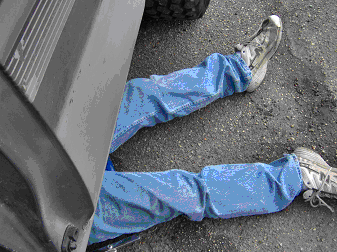
I hope you find this information helpful. It may be useful to anyone installing crawler gears. At least I got you about halfway into the case.
Happy Motoring!
Reserector
